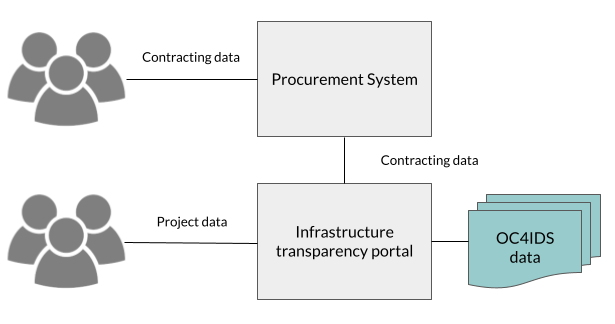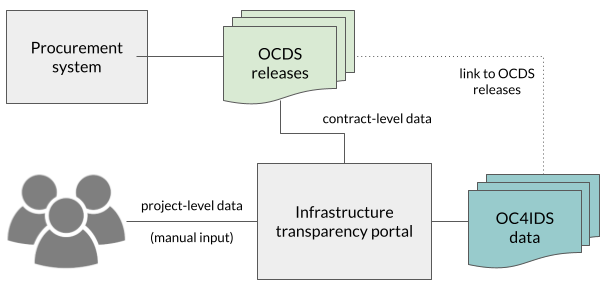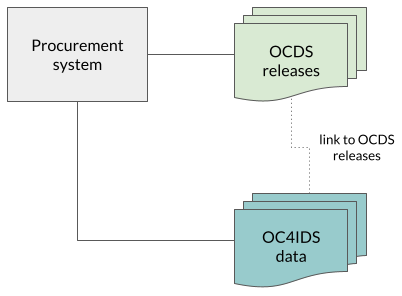Modelos de implementación¶
La implementación del OC4IDS implica combinar datos sobre proyectos de infraestructura y procesos de contratación. Esta guía describe algunos ejemplos de modelos de implementación utilizados por los publicadores de OC4IDS. No es una lista exhaustiva, pero puede utilizarse para informar su implementación.
Las fuentes de datos pueden incluir portales de transparencia de infraestructura, sistemas de adquisiciones y sistemas de administración de proyectos. La implementación del OC4IDS también puede implicar el uso de datos de contratación publicados en formato OCDS.
En esta guía analizamos opciones para la recopilación de datos, el flujo de datos entre sistemas y la publicación de datos. Para obtener más información sobre el diseño de la arquitectura del sistema para respaldar este proceso, consulte la guía Arquitecturas del sistema en la documentación del OCDS.
Portal independiente de transparencia de infraestructura¶

En este modelo, las entidades contratantes ingresan datos a nivel de proyecto y contrato directamente en un portal de transparencia de infraestructura. El portal publica datos del proyecto y datos resumidos del proceso de contratación en formato del OC4IDS. CoST Honduras utiliza este modelo al igual que CoST West Lombok.
El principal beneficio de este enfoque es que es relativamente simple porque no implica la integración de datos de diferentes sistemas. La desventaja de este enfoque es que puede aumentar la carga de ingreso de datos para las entidades contratantes que también podrían necesitar ingresar datos del proceso de contratación en un sistema de adquisiciones separado.
Portal integrado de transparencia de infraestructura y sistema de adquisiciones¶

En este modelo, las entidades contratantes introducen los datos del proyecto directamente en un portal de transparencia de infraestructura, mientras que los datos del proceso de contratación se importan de un sistema de contratación existente. A continuación, el portal publica los datos del proyecto y los datos resumidos del proceso de contratación en formato del OC4IDS.
Para cada proyecto, el portal de transparencia de infraestructura necesita unir los datos del proyecto introducidos por la entidad contratante con los datos de contratación importados del sistema de contratación. Si los datos de contratación incluyen identificadores de proyecto, este proceso puede automatizarse. De lo contrario, las entidades contratantes tienen que asociar manualmente los contratos con los proyectos.
CoST Ucrania utiliza este modelo en su portal de transparencia de infraestructura, que importa datos de Prozorro, el sistema nacional de adquisiciones. Los identificadores de proyectos no se capturan en Prozorro, por lo que las entidades contratantes relacionan manualmente los contratos con los proyectos.
El principal beneficio de este enfoque es la reducción de la carga de introducción de datos para las entidades contratantes, que sólo tienen que introducir los datos de contratación en un sistema. Cuando los datos del sistema de contratación incluyen identificadores de proyectos, la carga se reduce aún más, ya que el portal de transparencia puede cotejar los contratos con los proyectos sin intervención manual. Los inconvenientes de este enfoque son la mayor complejidad del portal de transparencia y la posible necesidad de realizar trabajos de desarrollo en el sistema de contratación para permitir el acceso a sus datos.
Cuando el sistema de adquisiciones publica datos OCDS, hay dos beneficios adicionales:
El comando convert-from-ocds del kit OC4IDS puede utilizarse para generar datos OC4IDS utilizando los datos OCDS como entrada, lo que reduce la cantidad de desarrollo de software necesario.
Los datos OC4IDS publicados se pueden vincular a los datos OCDS del sistema de adquisiciones, lo que permite a los usuarios profundizar en datos detallados sobre los procesos de contratación relacionados con cada proyecto.

La plataforma Infraestructura Abierta de Nuevo León implementa un modelo similar:
Los sistemas internos recopilan, combinan y publican datos de proyectos y contrataciones utilizando OC4IDS y OCDS.
La plataforma Infraestructura Abierta consume los datos OC4IDS y OCDS y proporciona una interfaz para que los usuarios exploren y analicen los datos.
Para obtener más información sobre la implementación de Nuevo León, lea el Estudio de caso técnico.
Sistema de adquisiciones independiente¶

En este modelo, en lugar de implementar un portal de transparencia de infraestructura independiente, se amplía un sistema de contratación existente para recopilar los datos de los proyectos. Las entidades contratantes introducen los datos de los proyectos y los datos de contratación directamente en el sistema de contratación y asocian los contratos a los proyectos. El sistema publica los datos de los proyectos y los datos resumidos de contratación en formato OC4IDS y los datos detallados de contratación en formato OCDS. Los datos OC4IDS satisfacen las necesidades de los usuarios interesados en proyectos de infraestructura y los datos OCDS satisfacen las necesidades de los usuarios interesados en todo tipo de procesos de contratación.
La Autoridad de Contratación Pública y Enajenación de Activos Públicos de Uganda utiliza este modelo en su Portal de Contratación Pública.
El principal beneficio de este modelo es que no requiere el desarrollo de un portal de transparencia de infraestructura separado. La desventaja de este modelo es que podría implicar cambios significativos en los sistemas de adquisiciones heredados.